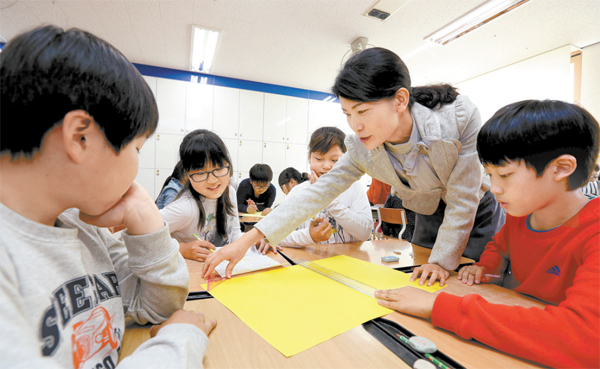A new way of educating

Choi Kyung-ah explains to her fourth-grade students the difference between vertical lines and horizontal lines during a math class at Tongjin Elementary School. By Ahn Seong-sik
They had been attending the supplementary course since May, receiving help in math and Korean four times a week. On this particular day, their teacher, Song Bo-ram, was helping them practice hangul (Korean characters). The first-graders had fallen behind the other students in their class and needed extra help.
Song gently explained the confusing vocabulary words and went over the mistakes they had made on their homework and recent tests.
Seoamli, where Tongjin Elementary School is located, is about 20 to 30 minutes from the center of Gimpo. With 508 students, one out of every 10 is a national welfare recipient.
In 2009, 6 percent of the school’s students were classified as performing below the basic academic level in a nationwide scholastic aptitude test. That number was higher than the national average, at 1.6 percent.
The next year, the school was chosen as part of a new government initiative to operate as a so-called creative-management school, and things slowly started to change.
Tongjin Elementary School hired intern teachers to tutor struggling students in the afternoon. At first there were more than 20 students who needed improvement, but year by year the students got better. Now, there are only about 10 students, including the two first-graders who require extra help.
“Now [the two first-grade students] score 90 percent in their dictation tests, despite the fact that they started out at 40 to 50 percent in the beginning,” said Song Bo-ram, one of the interning teachers.
Last year, for the first time, not a single student scored below average on the academic abilities exam.
The school also implemented other changes. They hired three new employees to handle non-academic work, lifting the burden off teachers and giving them time to plan their classes more efficiently.
“Because there were less administrative tasks, I could spend more time on planning [interesting activities] for the students in my class,” said Choi Kyung-ah, one of the fourth-grade homeroom teachers.
The Ministry of Education started the creative-management school initiative in 2009.
The program targets elementary schools that have more than 5 percent of its students performing under a basic academic level and middle and high schools with more than 20 percent of students underachieving. The program also targets schools in agricultural villages with subpar academic records.
The 464 schools participating in the initiative provide customized teaching methods to help students deal with their problem areas and identify a future career path.
“Before, the education system only encouraged students who had a high level of academic achievement, and now we are trying to help those whose abilities are not as well developed,” said Lee Yeon-wu, head of the creative teaching methods department at Tongjin Elementary School.
Sangdong High School - located in the middle of a former mining village in Yeongwol, Gangwon - is another school that benefited from the program.
Most of its 18 students come from single-parent households and have never had the opportunity to establish clear academic goals.
In an effort to inspire students, Sangdong High School offered a six-week aptitude course that helped each of them identify their interests. The students also attended Kidzania, a theme park in Jamsil, Songpa District, Seoul, that lets children experience different kinds of professions.
The school, which had nearly 21 percent of its students falling below basic academic performance rankings in 2010, now has all of its students performing above average.
Similarly, Sinchang Middle School, located on Jeju Island, offers a mentor program for its struggling students. Every morning, one high-achieving student and one teacher tutor those who need extra help in English and math.
“You can’t improve a student’s grades by simply nagging them to study more,” said Kim Ki-duk, the director of school affairs at Sangdong High School. “When they figure out what they want to do, and what they want to become, they will naturally [start to learn].”
BY Lee HAN-Gil [enational@joongang.co.kr]










with the Korea JoongAng Daily
To write comments, please log in to one of the accounts.
Standards Board Policy (0/250자)